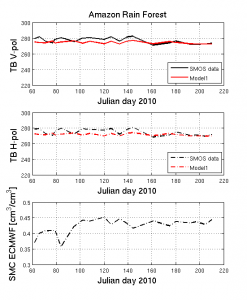MULTITEMPORAL TESTS OVER BROADLEAF FORESTS
R. Rahmoune, P. FerrazzoliTor Vergata University, DISP, Roma, Italy
In the framework of reprocessing activities of the Soil Moisture L2 algorithm, we are testing and refining the forward model for forests. In particular, we have considered multi temporal SMOS L1C signatures collected over broad-leaf forests. The brightness temperatures have been computed by taking L1C data, applying the XY to HV transformation, and averaging between 37.5° and 47.5°. Temporal samples with a significant amount of RFI have been eliminated.
The forward model is based on the basic formulas of Soil Moisture Level 2 ATBD (Algorithm Theoretical Basis Document). After some reprocessing, these parameters have been selected.
- Albedo: ω = 0.08 for all broad-leaf forests
- Roughness parameter: H_R= 0.3 (constant value)
- Optical thickness: τ = 0.2 LAI _MAX (LAI_MAX is the maximum yearly value of Leaf Area Index, as given by ECOCLIMAP)
The SMC (Soil Moisture Content) of ECMWF has been used has input to the model.
The selected test areas are summarized in the following table
| Area | Longitude | Latitude | LAImax | τ |
| Amazon forest | [-65.5,-64.5] | [1,2] | 6 | 1.2 |
| Central Africa | [16.5,17] | [5.5,6] | 3.5 | 0.7 |
| Chaco Argentino | [-60.6,-60.2] | [-24.6-24.2] | 3 | 0.6 |
This figure shows, for the area in Amazonia, the comparison between measured and simulated trends of TB at vertical (top diagram) and horizontal (middle diagram) polarization. The diagram in the bottom shows the trend of SMC estimated by ECMWF. Here the forest is thick. Measured and simulated results agree in indicating that the difference between the two polarizations is low, and variations of TB are small. The soil moisture is high all the time, but this has scarce effects, because the emission is dominated by the thick crown.
This Figure shows the same trends for the forest of Central Africa. The optical thickness is lower than in the previous example. Here the TB’s show appreciable variations, correlated with SMC. Simulated values agree with measured ones, with a slight underestimation of the variation observed on DoY 80.
This Figure shows the trends for the Chaco forest, in Argentina. This is a test area of several experiments, and the work is carried out in cooperation with Instituto de Astronomia y Fisica del Espacio (IAFE) of Buenos Aires. Also rainfall data (in mm) are available. In general the trends of TB are correlated both with ECMWF data and with rainfall events. The model reproduces well the results at both polarizations.
Overall, these results are promising, indicating that SMOS has the potential to retrieve soil moisture under broadleaf forests with moderate biomass. Further tests, involving a higher number of areas and more extended temporal intervals, are in progress.



